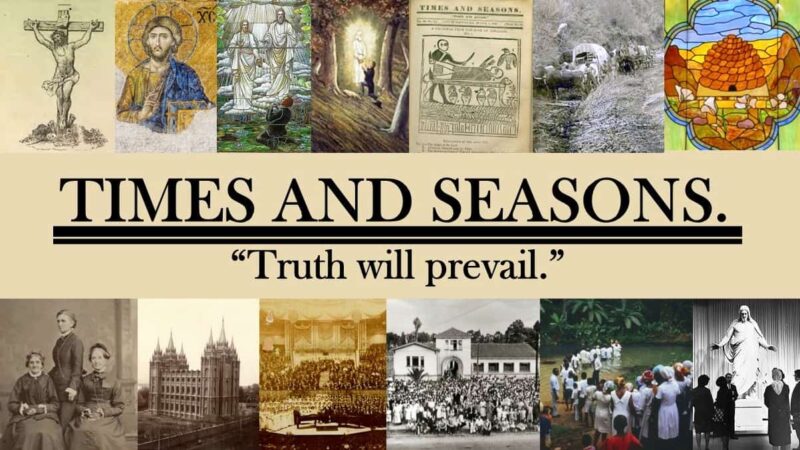In my last post, I discussed the process of canonization. While formal canonization has been rare since the late 19th century, key additions to the scriptural canon—such as the Pearl of Great Price and select sections of the Doctrine and Covenants—highlight a pattern shaped by prophetic authorship, broad communal use, and alignment with institutional priorities. These examples underscore a dynamic model in which “functional canon”—those texts already valued and widely cited—often lays the groundwork for what becomes official scripture. As the Latter-day Saint community continues to evolve, the interplay between tradition and revelation may yet open the door to future expansions of its sacred texts. With the foregoing in mind, what are documents that we could see canonized in the future?

Since Orson Pratt’s revisions in the 1870s, church leaders have been very reticent to add any documents to the canon, so it may be unlikely that we will see much added in the future. If we do, the most obvious examples of documents that are part of a functional canon at this time are “The Family: A Proclamation to the World” and “The Living Christ”. Both can claim authorship by the First Presidency and the Quorum of the Twelve. Both have precedent in the scriptures as a statement of belief, especially from Doctrine and Covenants 134 and the Articles of Faith. Both support the current institutional agenda of alliance with the Religious Right in the United States—the former through its stance on the culture wars, and the latter for its emphasis on the Christocentric nature of the modern church. And both have wide distribution in the Church, through inclusion in Church publications and courses of study and through frequent references in talks and discussions. In writing about the canonization of section 137, Stephen Smoot noted that the document “was being used by leaders of the Church as an authoritative source and was understood to carry significant doctrinal weight” before its canonization in 1976. “In this regard it may not be out of order to compare how this vision was handled before its canonization with how the family proclamation is typically used in the Church today.”[1] While “The Family: A Proclamation to the World” is divisive because of its involvement in the cultural wars (and I would personally prefer it to stay in it’s current status), it feels like there is enough inertia in its use as functional canon (with efforts from Dallin H. Oaks to maintain that momentum) that it is likely to still remain high on the list for potential canonization in the foreseeable future.
Most dictated revelations and visions of nineteenth century Church leaders have passed the point of relevance for the Church. Although the work of the Joseph Smith Papers and the Wilford Woodruff Papers have highlighted noncanonical revelations recorded by these two prophets, most of them are not pertinent or supportive of current institutional priorities. Also, some of these revelations (along with a few recorded by John Taylor) lend more support to the beliefs of fundamentalist Mormon groups than our church’s leadership are likely to be comfortable with. These considerations were likely contributing factors to the rejection of these documents when they were considered for addition to the Doctrine and Covenants or Pearl of Great Price in the 1920s and 1970s. They could still be added with an eye towards emphasizing that prophets after Joseph Smith did receive revelations, adding more revelations directed to women to the Doctrine and Covenants, or addressing specific historical controversies, but I find it unlikely that this will happen.
That being said, there are a few revelations and visions that have either hovered on the edge of functional canon or that could fill a gap in scriptural support for specific temple practices. One document that does have potential is the dream Brigham Young recorded in 1849, which has been printed repeatedly in manuals (including both the Joseph Smith and Brigham Young entries of Teachings of the Presidents of the Church) and cited occasionally. Wilford Woodruff’s revelation on February 23, 1877, which enabled temple proxy work for people not related or known to the individual acting as proxy, could also support the emphasis on temple construction and temple work by church leaders. In addition, Woodruff’s landmark 1894 talk, “The Law of Adoption” (in which he laid the foundation for the emphasis on family history), could also offer a similar revelatory undergirding to modern family history research and temple work. Thus, there are a couple nineteenth century revelations and visions that have seen some use and are aligned with institutional priorities.
There are also a few other statements or documents by church leaders that could be considered for canonization. An excerpt from Joseph Smith’s Questions and Answers in the July 1838 Elder’s Journal about the “fundamental principles of our religion” emphasizes the Christocentric mission of the Church and has already had a broad distribution in the Church. Joseph Smith’s King Follet Discourse is a capstone summary of his Nauvoo teachings and has been a part of the functional canon since early on (though it would probably require cutting a few things out). The Salt Lake City Temple dedicatory prayer would be a nice counterpart to the Kirtland Temple dedicatory prayer (section 109), and provides some commentary on the need for unity and respect, even in times of heated political debates. The April 7, 1931 decision of the First Presidency on debates over evolution or the September 1925 treatise “‘Mormon’ View of Evolution” would provide broader visibility to the Church’s stance (or lack thereof) on evolution. “When Are Church Leaders’ Words Entitled to the Claim of Scripture?” by J. Reuben Clark, Jr. has become the classic statement of the need to be discerning while quoting church leaders that has been cited from time to time (slowly edging its way into functional canon). The 1963 statement on Civil Rights that Hugh B. Brown introduced is still relevant today, and would be helpful in countering the Church’s historic reputation for bigotry that the priesthood and temple ban fostered (as would Russell M. Nelson’s October 2020 talk “Let God Prevail”). The 1978 “Statement of the First Presidency Regarding God’s Love for All Mankind” would support the Church’s efforts in the realm of interfaith relationships and cooperation. The “Restoration of the Fulness of the Gospel of Jesus Christ” proclamation from 2020 is also a document that Church leaders seem to be determined to have treated like “The Living Christ”. If we’re thinking larger-scale additions, the Teachings of the Presidents of the Church: Joseph Smith may also be considered part of the functional canon that could be formally canonized at some point. These documents are among the ones that I would suspect are on the shortlist for canonization, should Church leaders decide to employ the formal canonization process less conservatively than they have been since the 1880s.
A final group of documents may be worthy of consideration for canonization that would support efforts to say that women are valued in the Church. While Russell M. Nelson has stated that women’s voices are important and that we need to listen to them, there is much progress still to be made. The Church’s history department, gratefully, has been making great strides in publishing and utilizing these types of sources. The inclusion of documents by women in the formal canon (or efforts to encourage their use in the functional canon) would go a long way in making the voices of women more visible and accessible to members of the Church worldwide. The easiest and most straightforward lift would be to use At the Pulpit: 185 Years of Discourses by Latter-day Saint Women in this way. There are a few other documents that could conceivably be considered a part of our functional canon at this point, like the minutes of the original meeting of the Nauvoo Female Relief Society, Lucy Mack Smith’s memoirs, and Eliza R. Snow’s hymns. I am uncertain about whether this idea would actually find support among Church leadership, but it is a potential direction that could be taken.
The future of canonization in The Church of Jesus Christ of Latter-day Saints remains uncertain, but not without possibility. As historical, doctrinal, and institutional priorities evolve, so too might the canon—especially as functional use continues to shape the landscape of what members and leaders consider authoritative. Whether through proclamations already woven into the fabric of church discourse, overlooked revelations that reinforce current temple emphases, or voices long underrepresented in sacred texts, the potential additions to the canon reflect both the Church’s past and its aspirations for the future.
There will probably be a part 3 to this series, but I need to address a related topic through another ongoing series first.
For more, see the Chad Nielsen On Scriptures page.
Footnote:
[1] Stephen O. Smoot, “Joseph Smith’s 1836 Vision of the Celestial Kingdom: A Historical and Contextual Analysis,” in Joseph Smith as a Visionary: Heavenly Manifestations in the Latter Days, ed. Alonzal L. Gaskill, Stephan D. Taeger, Derek R. Sainsbury, Roger G. Christensen (Provo: Religious Studies Center at Brigham Young University, 2025), 220.

Comments
7 responses to “Canonization, Part 2: The Future of Canon?”
I would like to see Joseph Smith’s 1832 First Vision account added to the PofGP, alongside his 1838 account. Not only is the earlier account inspiring in itself, but the juxtaposition of the two, within the canon, could encourage reflection about how our understanding of spiritual events can change over time, the recording and transmission of sacred experiences, the development of scripture and theology, and the significance of primary-source documents in the Restoration.
I totally agree! I have a little compilation of documents that I keep tinkering with that would be my own suggestions for addition to the canon, and that one is definately among them.
I have thought about whether an “LDS apocrypha” should be created. Uncanonized revelations, sermons, teachings, visions and the like all contained in one book. What do you think?
AlanJayWhite, the little compilation that I mentioned in my last comment is basically what you describe. The problem that I think people would run into would be finding agreement on what should be included. There are hundreds of those types of documents that could be included. Which ones should be included and which ones left out? It’s a tough question. Out of curiosity, what would you suggest?
Not for nothing, it may be worth mentioning that if Bruce R. McConkie had his way, the Wentworth Letter would’ve been canonized in the circa 1976/1981 Pearl of Great Price, giving us two First Vision accounts, &c.
Chad Nielson, I would personally include the king follett discourse, the lectures of faith, the law of adoption, what is truth poem,something from the journal of discourses, the salt lake dedicatory prayer, possibly the proclamations and some non canonized revelations from Joseph Smith. It is definitely open to discussion and would probably be more of an educational book rather than spiritual book.
Best Loved Talks of the Lds People And the old LDS Library Subscription service kind of filled the broad need in the past. If engagement with certain talks is of value, the metric the Church could use its internal analytics on the gospel library AP. BYU Speeches or YouTube most viewed are interesting too.